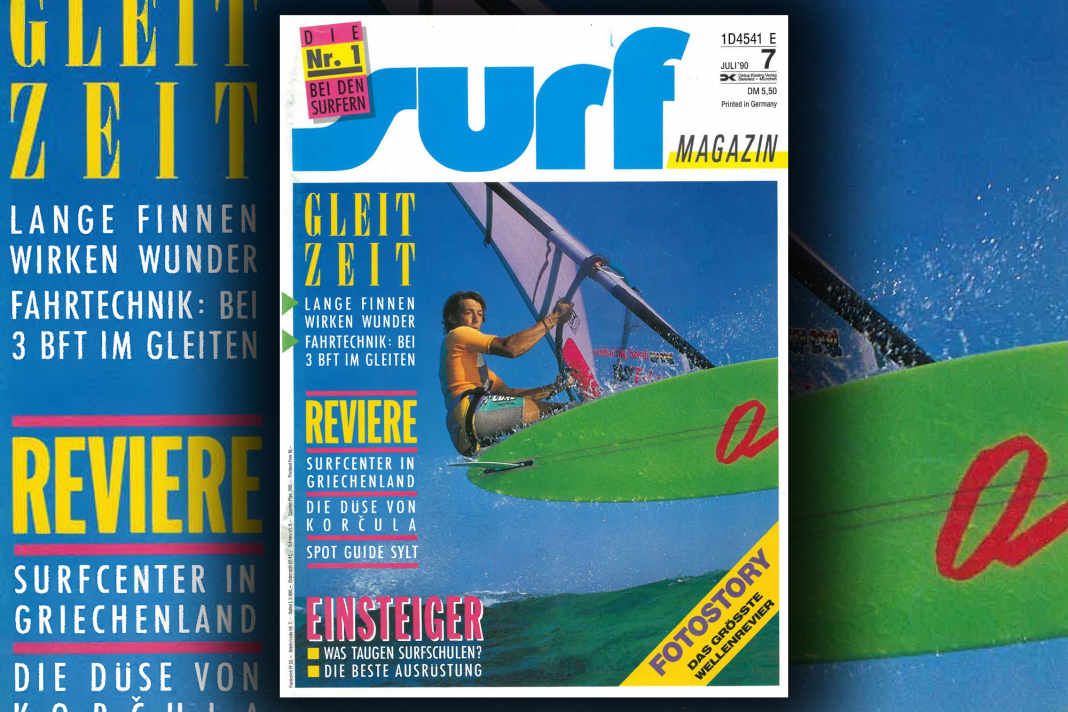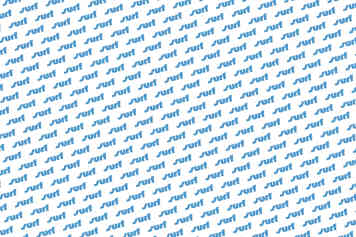





Powerbox and colourful sails
Two material innovations that we take for granted today are presented to the public in the summer of 1990: Mistral and F2, two of the largest board manufacturers, jointly developed the Powerbox, which was to be installed in all of the brands' boards from 1991. The well-known US box had revealed weaknesses with ever larger fins and sails. "The strong piece at the tail is 16 millimetres wide and can take any 'slalom beating' from a fin without complaint," exults surf. Mistral co-developer Helmut Kirner believes: "Now the designers can finally make their fins unbreakable and more streamlined", while his F2 colleague announces that the new box will allow better planing. Even though the power box itself reached its limits in the 2000s and tuttle boxes had to be used for even greater forces - an absolute milestone! The other innovation was coloured mono film jointly developed by F2 and Hoechst, which at least partially offered an alternative to the transparent dreariness of sail design.
Cape Town - paradise or perverse?
Today a dream destination for thousands of windsurfers, wingers and surfers every winter, in 1990 still controversial and exotic: due to the "Cape Perestroika" and the looming end of apartheid, South Africa and its perfect spots are coming into focus. "Are you allowed to travel to South Africa?" asks surf F2 sail developer Klaus Walther, who has been travelling to Cape Town for years. He reports that, away from the hotspots, you don't notice much of the unrest at the time and welcomes the slow changes, but also emphasises that there are still a number of injustices. Otherwise, he raves about the marvellous conditions, many of which were still undiscovered at the time. However, professionals such as Robby Seeger and Jutta Müller are still reluctant to travel to the still largely isolated country, fearing sanctions such as those that existed in tennis.
Driving technique offensive
Big riding technique offensive in summer: the "Fun Trainer" for advanced riders shows foot control and the optimum technique for gliding and going upwind, while the "Fun on board" special is all about beginners. In addition to a great report from a surf course, there is a voucher for a taster lesson and lots of basic knowledge. From board sizes and rig components to technical terms, windsurfing enthusiasts will find everything they need to get started.
And what else?
- Mistral is reorganised, in future the brand will be owned equally by Gaastra and the manufacturer Fritzmeier. In addition, the head office is relocated from Munich to Upper Bavaria, with Rainer Ramelsberger as the new boss.
- Pearls from the advert: NeilPryde advertises the new Wave Slalom sail with "Twin Cam". Two removable cambers and three "convertible battens", which can be used shorter or longer, offer no less than eight different setup options for different conditions. A dream for trim nerds, a nightmare for anyone who wants to get on the water quickly.
- Gleitzeit '90" is all about planing and planing through. In addition to pumping technique and sail sizes ("on slalom boards, 7.5 square metres is the limit of what is reasonable"), it is also about the new, long fins: At up to 38 cm, the "giant fin spines" are surprisingly easy to ride as long as you don't go round a bend.
- Gaastra brings a "batten-free light sail" made of mono film with an almost straight mast sleeve for beginners and intermediates. Conclusion after the first test of six square metres of film in one piece: For beginners in light winds it's okay, sensationally easy to sheet start - but lots of control problems, a spongy feel and deafening rattling in stronger winds.
- Much sought-after in the pre-windfinder era: an overview of the telephone numbers of surf schools, stations and weather services that provide information about the wind on Bavarian and Austrian lakes
- At the World Cup in Omaezaki, Japan, the riders only start after Greenpeace has analysed the water. Rumours had previously been circulating about an incident at the nearby nuclear power plant
- "Windsurfing requires intelligence, tenacity and speed. Windsurfing requires imagination and poetry" - says Georgios, a painter from Mykonos, who has chosen windsurfing as his second art form and is considered the inventor of the duck tack.
- The Spot Guide Sylt (to tear out!) shows the best spots on the west and east side and lists four surf shops on the island
You can click through the entire magazine in the gallery above!
More surf reviews:
- These were the highlights in surf 4/1977
- These were the highlights in surf 6/1978
- These were the highlights in surf 4/1979
- These were the highlights in surf 9/1980
- These were the highlights in surf 11/1980
- These were the highlights in surf 4/1981
- These were the highlights in surf 5/1982
- These were the highlights in surf 4/1983
- These were the highlights in surf 10/1983
- These were the highlights in surf 9/1984
- These were the highlights in surf 8/1985
- These were the highlights in surf 8/1986
- These were the highlights in surf 9/1986
- These were the highlights in surf 5/1987
- These were the highlights in surf 8/1988
- These were the highlights in surf 5/1989
- These were the highlights in surf 7/1989
- These were the highlights in surf 4/1990
- These were the highlights in surf 6/1991
- These were the highlights in surf 3/1992
- These were the highlights in surf 9/1993
- These were the highlights in surf 10/1993
- These were the highlights in surf 4/1994
- These were the highlights in surf 7/1995
- These were the highlights in surf 11-12/1996
- These were the highlights in surf 7/1997
- These were the highlights in surf 8/1998
- These were the highlights in surf 4/1999
